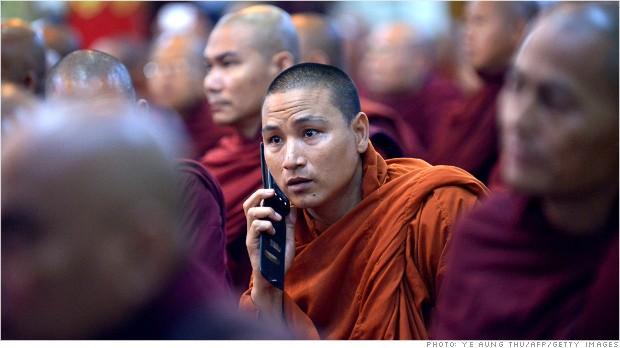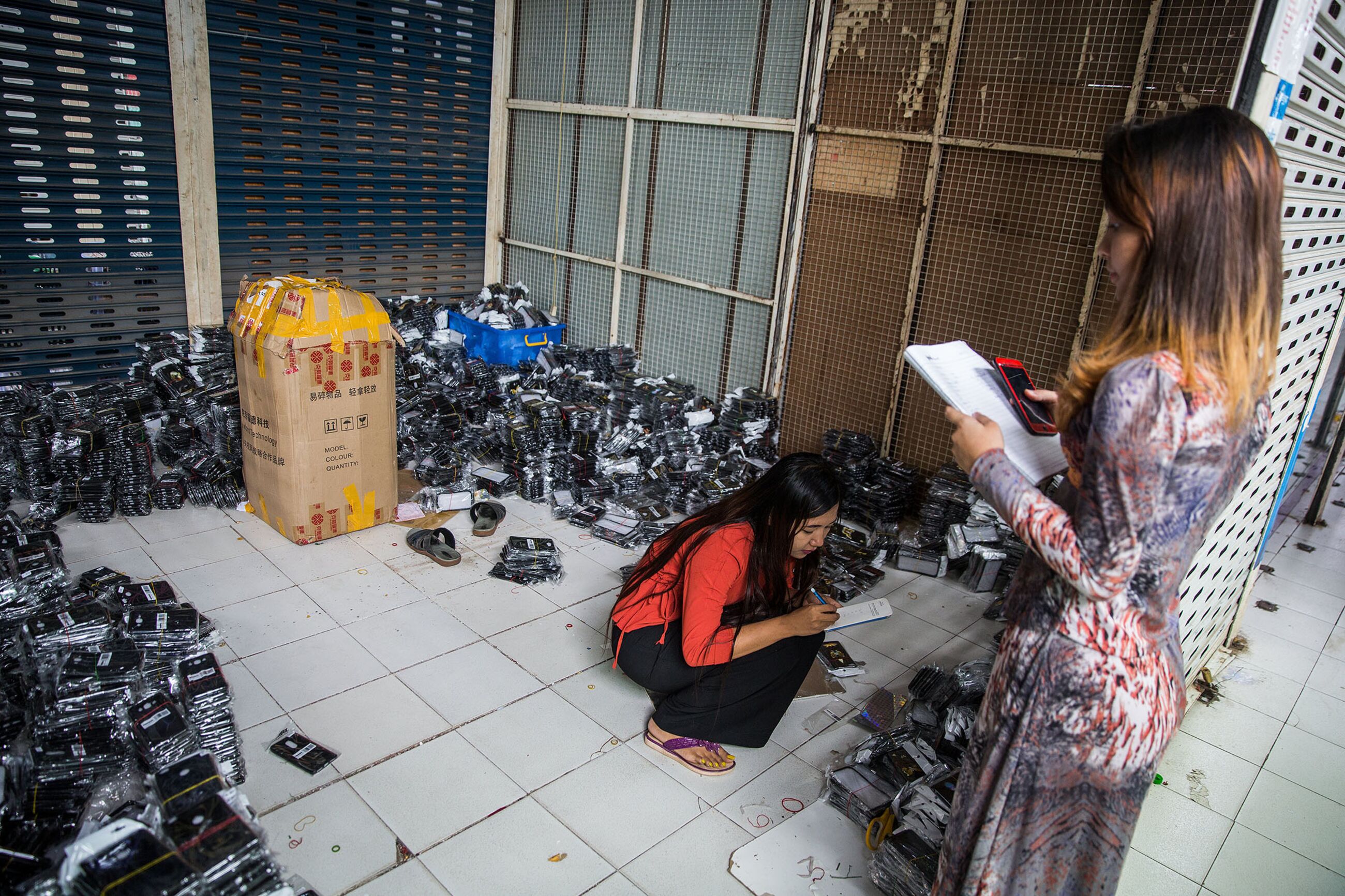
The Unprecedented Explosion of Smartphones in Myanmar
By Philipp Heimans for Bloomberg
Programmers in t-shirts and jeans tap away at laptops beneath posters exhorting them to “Innovate” and “Dance Like Crazy.” Local demand for their smartphone apps and websites is exploding, and in the last 12 months they’ve inked marketing contracts with multi-nationals like Samsung Electronics Co. and Nestle SA.

What’s remarkable about Ye Myat Min’s internet success story is that it’s happening in a country where most people are farmers, the majority of roads are unpaved, and reliable electricity remains a luxury: Myanmar.
Just six years ago, when Myanmar was emerging from decades of isolation imposed by its military dictatorship, phones were an extravagance available only to the rich and well-connected. Only North Korea had fewer mobile phones. Now, though, after the airwaves were opened to foreign investors willing to bear some of the cost of building a vast wireless network, almost everyone in Southeast Asia’s poorest country is connected.
“It’s amazing,” said Marc Einstein, an analyst at Tokyo-based consulting firm ITR Corporation, who’s advised several telecommunications businesses moving into Myanmar. “I can’t think of another market where things have transformed so quickly.”
The watershed came in 2013, when a government led by former president Thein Sein ended the state monopoly over phone service. A smartly planned tender offer made sure new licenses weren’t a simple giveaway. Investors had to commit to covering the country’s farthest reaches, not just its cities, where population density makes for easier money.
By the following year, Norway’s Telenor ASA and Qatar’s Ooredoo Q.S.C. were starting to spend billions of dollars to cover a land mass the size of Texas, spread over steep mountains and lowlands that flood in monsoon season. Japanese carrier KDDI Corp. and trading company Sumitomo Corp. struck partnership deals with the government’s Myanmar Posts and Telecommunications to invest another $2 billion.

Now there are thousands of cell phone towers sprouting out of forests and remote rice paddies, running off their own solar-powered electricity. Refrigerated boxes protect their computerized brains from Myanmar’s sweltering heat.
In 2015, Myanmar signed up more people for mobile phone service than any country in the world except China and India, according to the Asian Development Bank. By last June, about 90 percent of the country’s 54 million people had access to a phone with internet service, the Myanmar Computer Federation says. Some 60 percent use Facebook or other social media to get news, state media reported in April. In Yangon, the country’s biggest city, you can now hail a car using ride-sharing apps like Uber or Grab.
Back in the days of the junta, the identification chip that goes inside a cellphone, a SIM card, could run you more than $2,000 on the black market. These days, a data-enabled card sold by Ooredoo, the Qatari company, can be had for $1.50. A smartphone itself can cost less than $20. And domestic calls are about 2 cents per minute.

Naing Win, a 30-year-old man selling waffles from a pushcart in Yangon, says for years he had no way to communicate with his family back home in the countryside, except by post. “It’s much easier” now that everyone has a smartphone, he said.
Thiri Thant Mon, owner of a small investment bank in the city, says she still remembers how magazines from the outside world used to arrive weeks late because censors needed time to comb through them.
“Suddenly because we’re on internet,” she said, “people realize what the rest of the world looks like. Now it’s like everybody on the street is talking about Trump. A few years ago, nobody knew what was happening in the next town.’’
If there is a risk in Myanmar’s mobile phone miracle, it’s to the companies who’ve invested in it, according to Einstein, the telecom consultant. Asia is full of examples, he says, where regulators have allowed cut-throat competition that drives prices down fast, but also puts firms out of business.
In January, Myanmar may have taken a step in that direction when it issued a fourth license to a group led by Viettel Group, the state-owned carrier run by Vietnam’s Ministry of Defense, which has a track record of entering markets in far flung places like Haiti, Tanzania and Cambodia—and mowing down the competition.
Viettel didn’t respond to a request for comment. Representatives for all three of Myanmar’s current carriers said the companies have always assumed they would have to deal with a fourth competitor. Einstein, the analyst, summed it up this way: “Things are going to get nasty.’’

For the average Burmese person, though, not so much.
Most people in Myanmar still have to carry wads of cash in their pockets — banks are scare and only 5 percent of the population has an account, according to the United Nations — but a crush of new apps may solve that.
Read more: Myanmar’s Tourism Destination Dreams Fade Amid Empty Hotels
One of them called Wave Money, an app developed by Telenor with a local partner, allows people to make payments or transfer money, and even withdraw cash at thousands of general stores using nothing besides their smartphones. Some 450,000 people have used the service since its launch last August, according to the company.
“Myanmar is crying out for better financial services and smartphones make this possible without the usual brick-and-mortar investment,” said David Madden, founder and CEO of Yangon-based business incubator Phandeeyar.

Smartphones for everyone means Myanmar’s farmers can now get addicted to online games just like everyone else. Local software developer My Play says it already has one million users for its five games, including one that allows players to race the obstacle course of Myanmar’s roads in a rickshaw. In March, Australia’s Isentric Ltd. said it agreed to purchase the company for $4.6 million.
Myanmar is offering the world an object lesson in how the internet can render obsolete some elements of physical infrastructure, like fixed line phones or even bank branches, but there are still things the internet can’t replace.
At nexlabs, the Yangon start-up, the electricity failed just as CEO Ye Myat Min sat down to talk about Myanmar’s mobile phone gold rush. The young entrepreneur seemed unfazed as the office plunged into darkness for a few seconds before backup generators roared to life.
Heijmans is a correspondent based in Yangon. With assistance from Jason Clenfield, Grace Huang, Masumi Suga and Mai Ngoc Chau.





